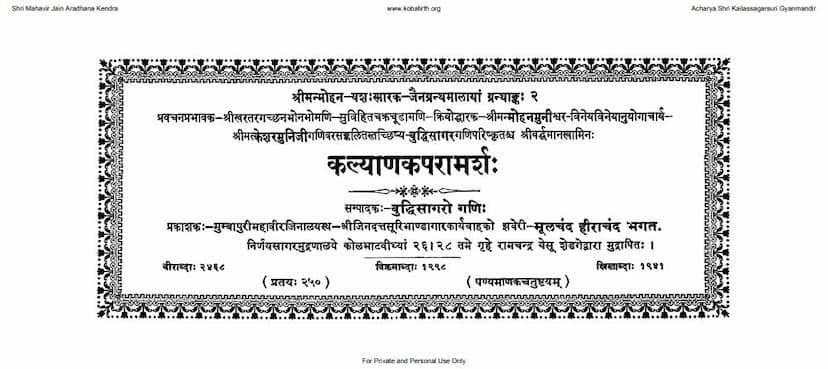Kalyanak Paramarsh
Added to library: September 2, 2025

Summary
Here's a comprehensive summary of the provided Jain text, "Kalyanak Paramarsh" by Buddhisagar, based on the content of pages 1-12:
Book Title: Kalyanak Paramarsh (Consideration of Auspicious Events) Author: Buddhisagar Publisher: Shri Jinadatta Suri Bhandagar, Bombay Compiled by: Shrimat Kesharmuniji Ganivar Refined by: Buddhisagar Ganivar
Core Theme: The central purpose of this text is to discuss and clarify the nature of the "Kalyanaks" (auspicious events) associated with Tirthankaras, particularly Lord Mahavir. It directly addresses and refutes the idea that certain events, like the conception or transfer of the fetus, might be considered inauspicious, arguing that all events related to a Tirthankara's life are fundamentally auspicious.
Key Arguments and Discussions:
-
The Concept of "Kalyanaks": The text begins by referencing scriptural sources that define the five primary auspicious events of a Tirthankara's life: chavana (descent from heaven), garbhavataran (conception/descent into the womb), janma (birth), diksha (initiation/renunciation), and gyan (enlightenment/omniscience). It also acknowledges the sixth event, nirvana (liberation), as a crucial part of their life.
-
The Controversy of the Sixth Kalyanak (Fetal Transfer): A significant portion of the text is dedicated to discussing the event of Lord Mahavir's fetal transfer. Lord Mahavir was initially conceived in the womb of Devananda, but due to divine intervention, his embryo was transferred to the womb of Trishala. Some interpretations or schools of thought viewed this transfer (garbhapahar or garbha-harana) as inauspicious due to its association with an "unfortunate" lineage (Devananda's family, considered lower in status than Trishala's) or the act of removal itself.
-
Refuting Inauspiciousness: Buddhisagar, drawing upon various Jain scriptures and commentaries (like the Panchashaka, Kalpa Sutra, Acharanga Vritti, Sthananga Vritti, Kalpa Deepika, and works by Acharyas like Haribhadrasuri and Abhayadevasuri), systematically argues against this notion of inauspiciousness.
- Scriptural Basis for Auspiciousness: The author highlights verses that explicitly state that the events like conception, birth, renunciation, and enlightenment are auspicious (kalyana).
- Fetal Transfer as Auspicious: The text argues that the transfer of the embryo to Trishala's womb, while an "event," is still intrinsically linked to the divine plan and the eventual birth of a Tirthankara. Therefore, it is also a kalyanak. The term "transfer" (haranam or apahar) is interpreted as a movement towards a more auspicious destiny.
- "Wonder" vs. "Inauspiciousness": The text distinguishes between an event being "wonderful" (ashcharya-rup) and being "inauspicious" (ashubh or akalyanak). The fetal transfer, being a divine wonder, does not make it inauspicious.
- "Low-born" vs. "Auspicious": The argument that being born into a "low" lineage (Devananda's) makes the event inauspicious is refuted. The text points out that even if the initial conception was in a seemingly lower lineage, the divine act of transfer to Trishala's womb ensures its ultimate auspiciousness. The status of the lineage is irrelevant to the Tirthankara's inherent divinity and the auspiciousness of their life events.
- Scriptural Interpretations of "Sixth Kalyanak": The text explains that the fetal transfer is sometimes referred to as the "sixth" auspicious event not in a sequential numerical order, but rather as an additional, exceptional event that is part of the Tirthankara's life cycle, similar to how "ascetic worship" is sometimes listed as the tenth event in certain enumerations.
-
Debunking Counter-Arguments: The author addresses the criticisms of those who consider the fetal transfer inauspicious. They challenge these critics to provide scriptural evidence that the Tirthankara's life events are inherently flawed or inauspicious. They also question why, if the event were truly inauspicious, the Jain tradition celebrates Mahavir's birth with associated rituals, including recounting the dreams seen by his mother.
-
The Nature of Auspiciousness: The text emphasizes that auspiciousness (kalyanam) is related to shubha samruddhi (auspicious prosperity) and well-being. The birth and life of a Tirthankara bring immense benefit and enlightenment to the world.
-
Divine Intervention and Auspiciousness: The text notes that divine beings (like Indra) are involved in the major auspicious events of Tirthankaras. Their presence and actions are seen as confirmations of the auspiciousness of these events.
-
Tirthankara Mallinath: The text briefly mentions Tirthankara Mallinath, who was a female Tirthankara, to illustrate that the form of birth or lineage does not negate the inherent auspiciousness of the Tirthankara's life.
-
Conclusion on Lord Mahavir's Kalyanaks: The text firmly concludes that the six events of Lord Mahavir's life (including the fetal transfer) are indeed auspicious. It states that considering the fetal transfer inauspicious is a flawed perspective (durmukta or dushta-ukta) stemming from attachment or animosity rather than true scriptural understanding.
-
Compilation and Authorship: The work is presented as a compilation by Shrimat Kesharmuniji Ganivar and refined by Buddhisagar Ganivar, signifying a tradition of scholarly work within the Kharatara Gachha.
In essence, "Kalyanak Paramarsh" is a theological and philosophical discourse that delves into the definition and significance of Tirthankara's auspicious events, specifically defending the universally auspicious nature of all events in Lord Mahavir's life, including the controversial fetal transfer, by grounding its arguments in the Jain scriptures.